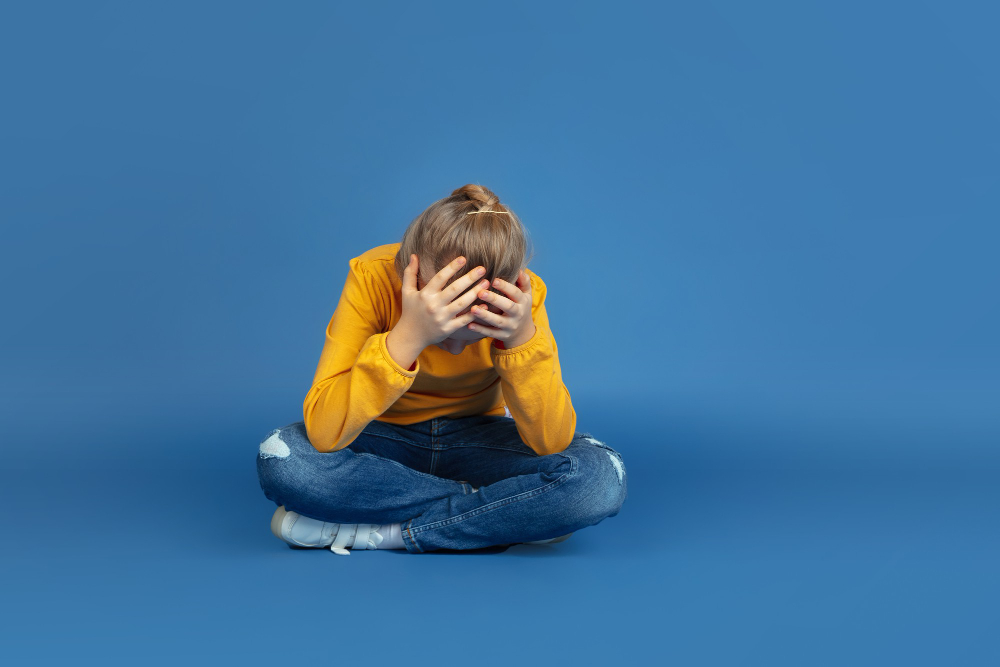
Childhood anxiety is a common but challenging experience. Anxiety isn’t easy for anyone, but children may not have the coping skills they need to help themselves work through symptoms. So, what can you do to help your child with anxiety?
In this article, we’ll discuss the prevalence of childhood anxiety and how anxiety manifests in kids so that you know what to look for. Then, we’ll talk about how to lower anxiety in children so that you can get symptoms under control and help your child find peace.
Prevalence Of Childhood Anxiety
General population statistics from 2016-2019 indicate that approximately 9.4% of kids in the United States aged 3-17 live with an anxiety disorder. However, some research suggests that the numbers may be even higher now. This is already a substantial portion of US children.
For kids with neurodevelopmental conditions such as autism spectrum disorder and ADHD, childhood anxiety is even more likely. In fact, statistics show that:
- Over 30% of kids with ADHD have at least one anxiety disorder.
- Over 39% of kids with autism spectrum disorder have at least one anxiety disorder.
How do you know if your child is experiencing anxiety or something else? If you’re not sure whether it’s anxiety or not, there are signs to look out for. A professional can thoroughly assess and provide a diagnosis for anxiety in relevant cases.
How Does Anxiety Manifest In Kids?
Anxiety symptoms vary from person to person. The way anxiety manifests in one child could look completely different from the way it shows up in another. However, there are common symptoms many children with anxiety experience.
Signs of anxiety in kids can include but aren’t limited to:
- Disproportionate worry regarding topics such as school, activities, friends, or family members
- Worrying about things even before they happen (may ask “what if?” questions out of fear)
- Appearing overwhelmed or crying more easily than other kids
- Trouble falling or staying asleep
- School refusal/not wanting to go to school
- Frequent unexplained gastrointestinal distress or other physical symptoms (e.g., muscle tension, grinding teeth, biting nails, frequent need to urinate)
- Fear of embarrassment and/or making mistakes
- Hiding from other people or avoidance of social activities
- Low confidence or self-esteem
- Panic attacks
- Nightmares
Note that there are different types of anxiety disorders, all of which can impact children. If anxiety primarily surrounds social situations, for example, a child may have social anxiety. On the other hand, if a child has excessive worry focused on various topics, they may have generalized anxiety disorder. Other anxiety disorders include separation anxiety disorder, specific phobia, selective mutism, panic disorder, and agoraphobia.
Feeling anxious and having a fully-fledged anxiety disorder isn’t the same thing. However, parents play a crucial role in helping kids with both. It is crucial to address childhood anxiety, regardless of what form it comes in. Teaching kids coping skills can lead to better anxiety management and health outcomes both now and later in life.
Ways To Lower Anxiety In Children
The goal is not necessarily to make anxiety go away. We all experience nervousness or feelings of anxiety from time to time, and with or without an anxiety disorder, it is important to have tools to navigate it. Some people have chronic anxiety disorders, and if that is the case for your child, it is not your fault. Many factors can increase the risk of chronic anxiety disorders.
With this in mind, the goal is to help your child manage anxiety. It can be tough to determine how to respond when your child actively experiences anxiety. Here are some solutions for parents of an anxious child, including tips, coping skills, and professional support.
Talk about anxiety with your child
Kids usually don’t know that anxiety is what they’re experiencing. Don’t let anxiety be the elephant in the room. If you notice frequent anxiety symptoms, pick a time to talk about what it means to feel nervous or anxious. Then, talk about how that might feel – a pounding heart, “butterflies in your stomach” sensation, racing thoughts, feeling scared, and so on. It is important that children can pinpoint what they’re feeling.
Children’s books about anxiety or general emotions can be helpful in teaching kids about the topic. Similarly, there are child-friendly videos about anxiety available for free online. Watch the video first to make sure that it’s suitable for your child. Different kids will respond in different ways, and age group or developmental level will play a role in determining how to talk about anxiety. Older kids may understand discussions of higher complexity that relate to mental health, whereas younger children may require basic language.
Talk about how to verbalize or communicate feelings. Some kids might also benefit from having a feelings wheel at home so that they have the words to describe their emotions and communicate them when things happen. If you experience anxiety yourself, you can model ways of expressing it and using healthy coping mechanisms.
Help your child find a solution
If your child expresses that they’re anxious about a specific event, walk them through their anxious thoughts. Don’t ask leading questions or tell them that there’s “nothing to worry about.” It is unhelpful for anyone with anxiety, especially children, to hear that there’s nothing to worry about when the fear’s running high. Instead, start with emotional validation (e.g., “It sounds like you’re nervous, is that right?”). Then, talk the child through exactly what they’re worried will happen and work together to build a plan for if it does.
For example, kids who face separation anxiety might be nervous about getting dropped off at school, worrying that you won’t come back. You can say, “I will be here at 3 PM. If I wasn’t here, what would you do?” Hopefully, they will respond with “tell the teacher,” “call you,” or a similar solution. If not, let them know what steps they can take if their fear comes to fruition.
Breathing exercises
Breathing exercises help your body and mind understand that you are calm and safe. This is because deep breathing lowers mental and physical markers of stress. There’s a variety of child-friendly breathing exercises to choose from. For example, the 5-5-5 breathing exercise, where you breathe in for five seconds, hold your breath for five seconds, and proceed to release your breath slowly over five seconds.
Many kids find visual tools helpful. If that’s the case for your child, you might find a breathing exercise video or meditation app for kids that instructs them to breathe in and out through pictures. These videos and apps are often calming, with child-friendly images and soft music. Even better, many breathing exercise videos and meditation apps for kids are free.
The 3-3-3 method for anxiety
Anxiety can make you feel overwhelmed and disconnected. Some kids might zone out, panic, be unable to make decisions, or experience other symptoms when they are anxious. The 3-3-3 method for anxiety is a simple grounding technique. Many kids and adults use it to ground themselves and reconnect with the world through their senses when they’re anxious.
To teach your child the 3-3-3 exercise, instruct them to:
- Name three things they can see (pets, shoes, household items – anything goes).
- Name three things they can hear (birds, music, wind – again, anything goes)
- Move three parts of their body (toes, fingers, arms, etc.)
The 5-4-3-2-1 method is a similar grounding technique where you name five things you can see, four things you can touch, three things you can hear, two things you can smell, and one thing you can taste. In situations where your child might not have tea, gum, or a snack around to name something they can taste, the 3-3-3 method for anxiety might be more accessible.
Teach kids how to ask for a break
Kids and adults can both benefit from knowing when to excuse themselves. If your child’s old enough, teach them how to ask to be excused when they feel anxious and need a few minutes to decompress. For some people, anxiety manifests in irritability, which can make this tip particularly valuable. Additionally, since anxiety can be worsened by sensory input – busy spaces with loud noises and lots of people, for example – a break can be incredibly helpful.
If you have a younger child, or a child who needs more support, you might remove them from overwhelming situations yourself if you notice that they start to feel irritable or anxious. When you do, help them self-soothe.
Keep calming sensory objects on hand
Stress balls or squishy toys, weighted blankets, white noise machines, chamomile tea, and other tools can help an anxious child find calm in difficult moments. These are just a couple of options. Teach your child how to use and access each tool – for example, you might teach them to ask an adult to help them make a cup of tea, or you might tell them that they can play with the squish toy during an anxious moment.
The idea is to build a toolkit. This should go alongside discussions about anxiety so that a child knows why these tools can help. The same goes for breathing exercises, meditation, and other activities. Make sure to discuss why and how coping skills help!
Retain realistic expectations for progress
Don’t let children avoid what makes them anxious. While your intentions are to lessen your child’s distress, avoiding causes of anxiety entirely is more likely to reinforce feelings of fear. Instead, set realistic expectations and take gentle steps in the right direction. At the same time, don’t push kids into situations that frighten them full force. It’s about balance.
Make anxiety-inducing tasks manageable. For example, it’s likely best to pick a short playdate rather than making a child attend a large slumber party if they want to spend time with other kids but are too nervous. Tell kids what to expect – for example, “The play date will last for two hours. I will pick you up at 5 PM.” Or, if they’re afraid to try a new food, let them know that they don’t have to finish it if they try it and don’t like it.
Do not try to turn your child into something they’re not. Pertaining to the sleepover example, there’s a difference between introversion and anxiety, though people can experience both. Being quiet or wanting alone time isn’t “wrong,” nor is disliking a certain food. The goal is to help your child create functional skills and solutions so that they can succeed in life activities like school and working with others. Strike a balance between helping kids learn important skills and honoring who they are or where they’re at in terms of skill-building.
Get professional support
Anxiety disorders can show up at any time in a person’s life. They affect quality of life, social relationships, education, and other important areas. If your child experiences distress related to feelings of anxiety often, symptoms that are a cause for concern, or if anxiety is affecting their daily life and well-being in any other capacity, it is important to reach out for help.
Mental health professionals such as therapists, psychologists, counselors, and social workers who work with kids use child-friendly approaches to help children find anxiety relief. For example, cognitive behavioral therapy, which can be combined with other modalities (like play therapy) and is known to reduce anxiety scores in kids, teens, and adults.
Remember that childhood anxiety is common and that you and your child aren’t alone. Parent involvement is key, so if you’re reading this, you’re already taking a great step!
How Behaven Kids Can Help
Behaven Kids offers a range of evidence-based therapy options for children with anxiety and other mental health concerns. These include but are not limited to child-parent psychotherapy, dialectical behavioral therapy, and cognitive behavioral therapy.
We have multiple locations in Nebraska and also offer telehealth. Our goal is to help parents and children find peace, confidence, and overall well-being. We understand that no two kids or families are alike. When you work with us, we will create an individualized plan for care that is unique to your child, their needs, and their goals.
Behaven Kids is here to answer your questions. Click here to learn about our services or call us at 1-402-926-4373.


